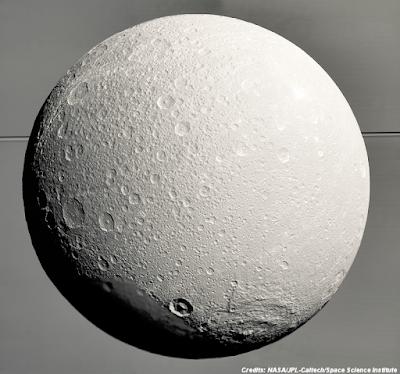Cassini's Final Breathtaking Close Views of Dione
By NASA
8-20-15
A pockmarked, icy landscape looms beneath NASA's Cassini spacecraft in new images of Saturn's moon Dione taken during the mission's last close approach to the small, icy world. Two of the new images show the surface of Dione at the best resolution ever.
Cassini passed 295 miles (474 kilometers) above Dione's surface at 11:33 a.m. PDT (2:33 p.m. EDT) on Aug. 17. This was the fifth close encounter with Dione during Cassini's long tour at Saturn. The mission's closest-ever flyby of Dione was in Dec. 2011, at a distance of 60 miles (100 kilometers).
The full set of images released today is available here.
"I am moved, as I know everyone else is, looking at these exquisite images of Dione's surface and crescent, and knowing that they are the last we will see of this far-off world for a very long time to come," said Carolyn Porco, Cassini imaging team lead at the Space Science Institute, Boulder, Colorado. "Right down to the last, Cassini has faithfully delivered another extraordinary set of riches. How lucky we have been."
Raw, unprocessed images from the flyby are available here.
The main scientific focus of this flyby was gravity science, not imaging. This made capturing the images tricky, as Cassini's camera was not controlling where the spacecraft pointed.
"We had just enough time to snap a few images, giving us nice, high resolution looks at the surface," said Tilmann Denk, a Cassini participating scientist at Freie University in Berlin. "We were able to make use of reflected sunlight from Saturn as an additional light source, which revealed details in the shadows of some of the images."
Cassini scientists will study data from the gravity science experiment and magnetosphere and plasma science instruments over the next few months as they look for clues about Dione's interior structure and processes affecting its surface.
Only a handful of close flybys of Saturn's large, icy moons remain for Cassini. The spacecraft is scheduled to make three approaches to the geologically active moon Enceladus on Oct. 14 and 28, and Dec. 19. During the Oct. 28 flyby, the spacecraft will come dizzyingly close to Enceladus, passing a mere 30 miles (49 kilometers) from the surface. Cassini will make its deepest-ever dive through the moon's plume of icy spray at this time, collecting valuable data about what's going on beneath the surface. The December Enceladus encounter will be Cassini's final close pass by that moon, at an altitude of 3,106 miles (4,999 kilometers).
After December, and through the mission's conclusion in late 2017, there are a handful of distant flybys planned for Saturn's large, icy moons at ranges of less than about 30,000 miles (50,000 kilometers). Cassini will, however, make nearly two dozen passes by a menagerie of Saturn's small, irregularly shaped moons -- including Daphnis, Telesto, Epimetheus and Aegaeon -- at similar distances during this time. These passes will provide some of Cassini's best-ever views of the little moons.
During the mission's final year -- called its Grand Finale -- Cassini will repeatedly dive through the space between Saturn and its rings.
The Cassini-Huygens mission is a cooperative project of NASA, ESA (European Space Agency) and the Italian Space Agency. NASA's Jet Propulsion Laboratory in Pasadena, California, manages the mission for the agency's Science Mission Directorate in Washington. JPL is a division of the California Institute of Technology in Pasadena. The Cassini imaging operations center is based at the Space Science Institute in Boulder, Colo. ...
Continue Reading . . .
See Also:
Pluto Flyby May Reveal Secrets of Saturn's Moon Titan
Mystery Object in Lake on Saturn's Moon Titan | PHOTOs
Hidden Ocean on Saturn's Moon, Enceladus – Could Support Life | VIDEO
REPORT YOUR UFO EXPERIENCE
 |


No comments :
Post a Comment
Dear Contributor,
Your comments are greatly appreciated, and coveted; however, blatant mis-use of this site's bandwidth will not be tolerated (e.g., SPAM etc).
Additionally, healthy debate is invited; however, ad hominem and or vitriolic attacks will not be published, nor will "anonymous" criticisms. Please keep your arguments "to the issues" and present them with civility and proper decorum. -FW